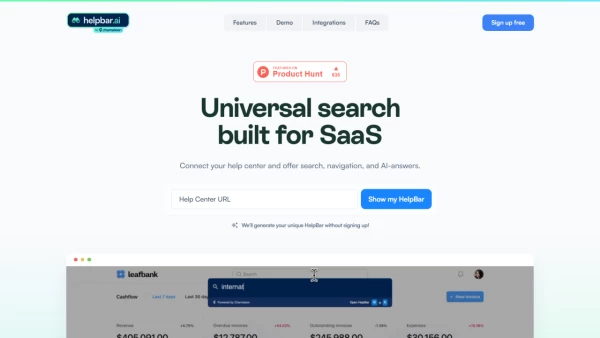What is HelpBar?
HelpBar enhances user assistance by providing an integration tool that enables universal search capabilities for Software as a Service (SaaS) platforms. By connecting users' help centers and offering search, navigation, and AI-generated answers, HelpBar addresses the critical need for quick and accessible information within applications. This system facilitates an improved self-service support environment which in turn can foster the development of power users, encourage efficient navigation, reduce support costs, and create a seamless experience by surfacing content from other tools like Loom videos, Figma prototypes, and more directly within the app .
Features
- Immediate search results: Provides AI-powered answers by connecting to the help center
- Customization options: Allows branding styles, pinned items, and keyboard shortcuts for app navigation
- Self-service support: Enables users to find help without leaving the app, reducing support tickets
- Content Integration: Surfaces tools like Loom, Figma within the app for enhanced productivity
Use Cases
- Improving user onboarding and speed to value
- Creating power users through efficient in-app navigation
- Reducing customer support costs by promoting self-help
- Integrating diverse toolsets within an app environment
FAQs
-
What types of platforms is HelpBar designed for?
HelpBar is specifically designed for Software as a Service (SaaS) platforms to enhance user experience with efficient, self-serve support options. -
How does HelpBar improve user assistance?
HelpBar enhances user assistance by providing immediate search results, customization options, self-service support, and content integration within the app. -
What are the key features of HelpBar?
Key features of HelpBar include immediate search results powered by AI, customization options for branding and app navigation, self-service support without leaving the app, and content integration with tools like Loom and Figma. -
What are some use-cases for HelpBar?
Some use-cases for HelpBar include improving user onboarding and speed to value, creating power users through efficient navigation, reducing customer support costs, and integrating diverse toolsets within an app environment.
Related Queries
Helpful for people in the following professions
Featured Tools
Join Our Newsletter
Stay updated with the latest AI tools, news, and offers by subscribing to our weekly newsletter.










